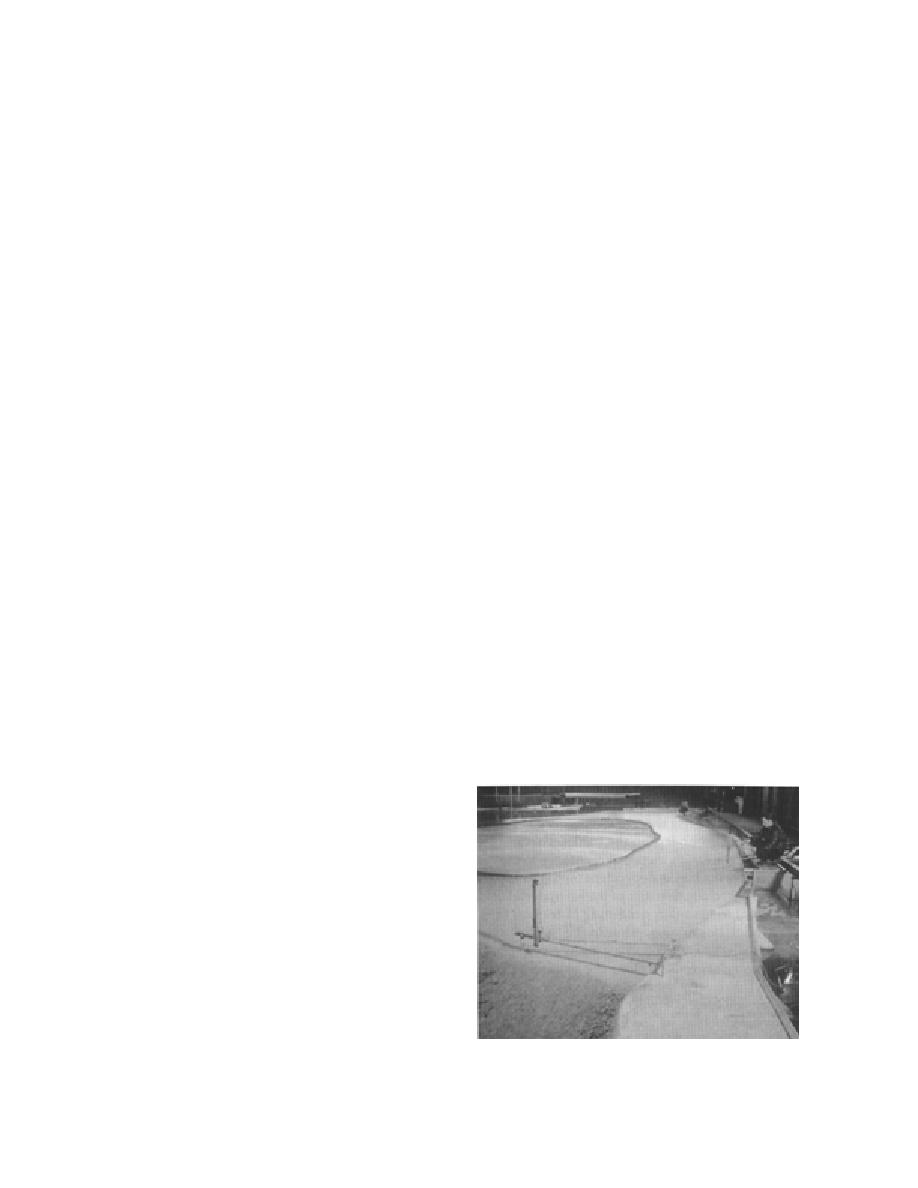
Unlike ice, plastics are nonwetting. Their be-
ulate continuum. Their strength behavior con-
havior as model ice may be more greatly influ-
forms to the Mohr-Coulomb failure criterion for
enced by surface tension than is real ice. Surface
granular materials. A further advantage to be
tension, or nonwetting, is of concern, especially
gained from pieces of crushed plastic is their high
for thin pieces that have negligible freeboard. It
angularity, which gives their accumulations a
may be a factor biasing results in studies on ice-
larger angle of internal resistance than accumula-
piece submergence and underturning. There are
tions of pellets. Ice jam initiation or ice arch forma-
methods to reduce nonwetting, such as adding a
tion is dependent on the angle of internal friction
wetting agent like nonfoaming detergent to the
and interparticle friction characteristics of the
model water, roughening the surface of the piec-
model ice material. Materials with a higher angle
es, or allowing a bacterial film to grow on the ice
of internal friction form ice arches more easily.
pieces. The latter two methods reduce the size of
Both the pellets and the fractured material can be
the meniscus formed by water against a nonwet-
obtained in large quantities at reasonable cost.
ting surface.
Dynamic similitude requires that the specific
Handling is a practical concern when model-
gravity of model ice, and the angle of internal
ing entails use of a large quantity of comparative-
friction of the modeled accumulations, be ap-
ly large model ice pieces. Whereas pumps can re-
proximately that of natural ice accumulations.
circulate water and fine solid material through a
Polyethylene has a specific gravity in the range of
model, pieces larger than 10 to 20 mm in diameter
0.915 to 0.925, almost identical to that of natural
may not pass through a pump.
ice (0.92). The specific gravity of polypropylene is
slightly less, at 0.90 to 0.91. The angle of internal
friction of model ice can vary widely, depending
Ice piece accumulations
Of primary importance is dynamic similitude
on the piece shape, angularity, and size distribu-
of ice-piece buoyancy, friction, and the angle of
tion. Most model ice materials have angles of
internal resistance of the ice-piece accumulation.
internal friction somewhat less than that reported
The hydrodynamic entrainment of pieces from
for natural ice accumulations. The fractured
the underside or perimeter of an accumulation
materials (due to their highly angular shape and
may be important for situations where accumula-
wide size distribution) have the highest angle of
tions are formed by flowing water. In many cir-
internal friction, which approaches that of natural
cumstances, small pieces of ice, on the order of 10
ice. In many situations, scant information exists
mm or less in diameter, may not behave like large
on the frictional characteristics of ice and model
ice pieces; a snowflake is not an ice floe, though
ice in contact with diverse surfaces.
both are pieces of ice.
It is common for ice-piece accumulations in na-
For many small-scale models, ice piece accu-
ture to consolidate by freeze-bonding or freezing
mulation can be replicated satisfactorily using
of pore water between ice pieces. Refrigeration
small pieces or beads of polyethylene or polypro-
may consolidate accumulations of ice pieces used
pylene plastic, to satisfy approximately the re-
quirement for geometric similitude. Ice is suitable
as model ice provided it behaves at model scale
as it does at full scale; in other words, provided
that the "stickiness" of the ice pieces is the same
at both scales. Model ice pieces can be cut from
plastic sheets, or they can be obtained as pellets
used for plastic molding or as fragments of
crushed recycled plastic. Polyethylene or poly-
propylene pellets work well for small-scale mod-
els requiring a large quantity of model ice. The
pellets are typically spherical or cylindrical with a
length of less than about 7 mm. In some circum-
stances, controlled crushing may produce the size
and gradation of pieces needed for a particular
model. Figure 5 shows an ice jam model formed
of crushed polypropylene. Accumulations of pel-
Figure 5. Physical model showing an ice jam formed of
lets or crushed plastic act as a noncohesive partic-
particulate material.
9



 Previous Page
Previous Page
